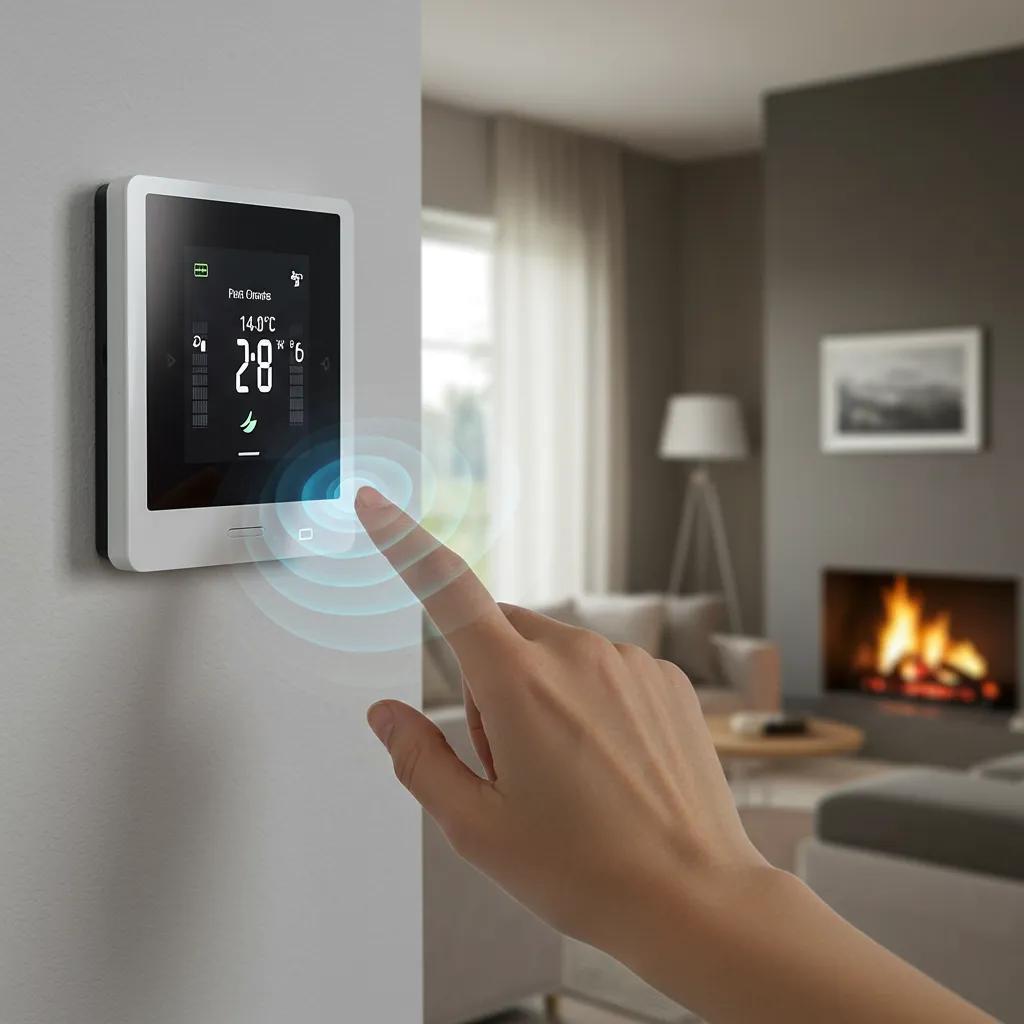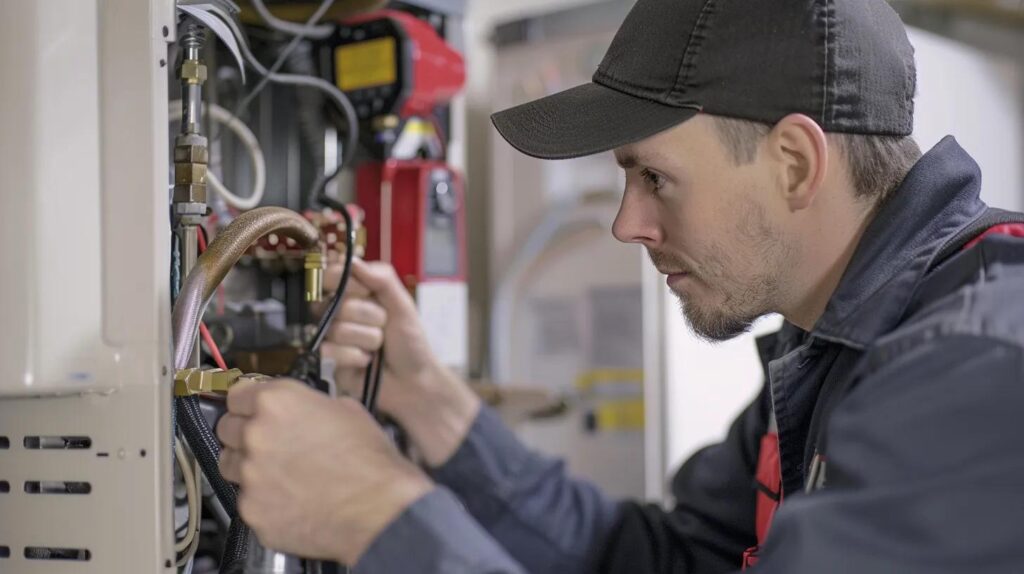Energy Efficient HVAC Systems 2025: Essential Tips to Save Energy and Reduce Costs
Upgrading to energy efficient HVAC systems in 2025 can cut utility bills by up to 50 percent while improving indoor comfort and air quality. Homeowners and businesses in Utah County face rising energy costs and evolving EPA regulations, making efficient heating and cooling solutions essential. This guide explains the best high-efficiency HVAC systems for 2025, practical savings strategies, local incentives, installation services by The Heating and Cooling Guys Inc., ROI calculations, smart thermostat integration, and emerging trends. You’ll learn how geothermal heat pumps, ductless mini-splits, and modern air-source systems outperform conventional units, which efficiency metrics to track, and how local rebates and tax credits amplify your return. Follow these expert tips to optimize system performance, reduce carbon footprint, and confidently plan your next HVAC upgrade.
What Are the Best Energy Efficient HVAC Systems for 2025?
The most energy efficient HVAC systems for 2025 blend advanced heat-transfer technologies with variable-speed operation and eco-friendly refrigerants. Geothermal heat pumps deliver stable performance by exchanging heat with the ground, while ductless mini-splits enable room-by-room control for targeted savings. Modern air-source heat pumps offer high Seasonal Energy Efficiency Ratio 2 (SEER2) and Heating Seasonal Performance Factor (HSPF) ratings, making them a viable alternative even in Utah’s colder months. Evaluating SEER2, HSPF, and Annual Fuel Utilization Efficiency (AFUE) ratings ensures you choose a system that balances upfront investment with long-term energy cost reductions. Top manufacturers now produce units achieving 20+ SEER2 and up to 25 HSPF, often backed by federal tax credits and local rebates.
Why Are Geothermal Heat Pumps the Most Efficient Choice?
Geothermal heat pumps achieve coefficients of performance (COP) of 3 to 5 by tapping stable underground temperatures. This mechanism reduces electricity consumption by up to 50 percent compared to air-source systems. Ground loops require higher installation costs but deliver rapid payback through lower operational expenses and long system life.
How Do Ductless Mini-Splits Provide Zoned Comfort and Energy Savings?
Ductless mini-split systems head-off energy losses inherent in ductwork by supplying conditioned air directly to each zone. Variable-speed compressors adjust output to occupancy and outdoor conditions, cutting waste during partial-load operation and boosting comfort in individual rooms.
What Makes High-Efficiency Air-Source Heat Pumps a Modern Solution?
New air-source heat pumps use variable-speed inverter technology and low-GWP refrigerants such as R-32 and R-454B. These components improve part-load efficiency, maintain heat output in colder temperatures, and reduce greenhouse gas impact, positioning them as a sustainable choice for both heating and cooling.
How Do SEER2, HSPF, and AFUE Ratings Impact HVAC Efficiency?
SEER2 measures cooling efficiency across variable conditions, HSPF quantifies heat pump heating performance, and AFUE indicates furnace fuel conversion rate. Higher ratings directly translate to lower kWh or therm usage per BTU delivered, guiding consumers toward systems with maximum savings potential.
Which Are the Top Energy-Efficient AC Units for 2025?
Below is a comparison of leading air conditioners rated for 2025:
| Make and Model | SEER2 Rating | HSPF Rating | Key Benefit |
|---|---|---|---|
| Trane XV20i | 22.5 | – | Ultra-quiet operation and variable speed |
| Carrier Infinity 26 | 26 | – | Industry-leading cooling efficiency |
| Mitsubishi SUZ-KA | 20.5 | 10.8 | Ductless flexibility and advanced controls |
| Daikin DZ20VC | 20 | 11 | Low-GWP R-32 refrigerant |
| Lennox SL28XCV | 28 | – | Premium inverter-driven performance |
These models offer advanced compressors and smart controls that adapt to load, enabling substantial energy savings and quieter operation.
How Can Homeowners and Businesses Maximize HVAC Energy Savings?
Maximizing HVAC energy savings involves proactive maintenance, airtight building envelopes, and intelligent control strategies. Regular filter changes and coil cleanings sustain airflow and heat-exchange efficiency, while sealing duct leaks prevents conditioned air loss. Upgraded insulation and weather-strip seals minimize envelope heat transfer, reducing system runtime. Integrating smart thermostats automates set-back schedules and links to occupancy sensors or outdoor weather data, ensuring precise temperature management. Strategic vent balancing and zoning avoid overconditioning unoccupied spaces. Together, these steps deliver immediate consumption reductions and extend equipment lifespan.
What Essential HVAC Maintenance Steps Improve Energy Efficiency?
Consistent maintenance—including filter replacement every 1–3 months, annual coil cleaning, and calibration of blower motors—sustains peak system performance. Proper lubrication of moving parts, inspection of refrigerant levels, and verification of safety controls further reduce wasted energy and prevent premature failures.
How Do Smart Thermostats Enable Automated HVAC Energy Savings?

Smart thermostats learn daily occupancy patterns and adjust setpoints to match homeowner routines. Integration with mobile apps and weather forecasts refines schedules, while remote monitoring provides usage insights. Automated temperature setbacks of 5–7 °F during absences typically yield 10–15 percent annual savings.
Why Is Sealing Ducts and Air Leaks Critical for Home Efficiency?
Duct leakage can squander 20–30 percent of conditioned air. Sealing gaps, poorly connected joints, and uninsulated runs prevents heat loss in attics or crawlspaces. Air-seal measures around windows, doors, and penetrations curtail drafts, stabilizing indoor temperatures and reducing HVAC cycle lengths.
How Does Insulation and Weatherization Enhance HVAC Performance?
Upgrading attic and wall insulation to R-49 and R-21 respectively slows heat transfer, cutting heating and cooling loads by up to 30 percent. Air-barrier installations, caulking, and spray-foam weatherization mitigate thermal bridging and moisture infiltration, preserving system capacity and lowering runtime.
What Are the Best Practices for Optimizing Airflow and Vent Management?
Balancing supply and return vents ensures even distribution of conditioned air. Installing zone dampers or transfer grills maintains proper static pressure, prevents short-cycling, and enables targeted climate control. Periodic airflow measurements confirm design CFM levels, maximizing comfort and efficiency.
What HVAC Energy Efficiency Incentives and Regulations Affect Utah County in 2025?
Utah County consumers can leverage federal tax credits, state rebates, and ENERGY STAR incentives to offset high-efficiency HVAC investments. The 2025 EPA refrigerant phase-out mandates transition from R-410A to low-GWP alternatives, affecting equipment availability and service practices. ENERGY STAR certification for heat pumps and furnaces indicates compliance with performance thresholds that qualify for streamlined rebate processing. Awareness of evolving regulations and local programs ensures optimal incentive capture and regulatory compliance.
Which Federal Tax Credits and Local Rebates Are Available for HVAC Upgrades?
In 2025, geothermal installations qualify for a 30 percent federal tax credit with no spending cap, while air-source heat pumps earn 30 percent credit up to $2,000. Utah utilities often match these amounts with rebates ranging from $300 to $1,200, depending on equipment efficiency tiers.
How Does the 2025 Refrigerant Phase-Out Impact HVAC Systems?
EPA Rule 22-03 bans refrigerants with GWP over 700, accelerating the adoption of R-32 and R-454B. New equipment and retrofits must use approved coolants, requiring updated technician certifications and the adoption of system designs optimized for lower charge volumes.
What Does ENERGY STAR Certification Mean for Your HVAC System?
ENERGY STAR certification marks products that exceed minimum SEER2 and HSPF benchmarks by 8–15 percent. Certified systems undergo rigorous third-party testing and often qualify for enhanced rebates and utility programs, delivering reliable savings and performance verification.
How Do Energy-Efficient HVAC Installation and Upgrade Services Work in Utah County?
Professional installation by The Heating and Cooling Guys Inc. ensures equipment is correctly sized, ductwork is optimized, and refrigerant charges meet manufacturer specifications. Energy audits begin with blower door tests and infrared scans to identify losses, followed by tailored recommendations for system replacement or tune-up. Preventative maintenance plans include periodic inspections, filter changes, and system performance reports, locking in efficiency gains year after year.
What Are the Benefits of Energy-Efficient HVAC Installation in Utah County?
Properly sized systems reduce cycle loss and humidity issues, while high-efficiency equipment slashes utility bills. Local expertise ensures designs account for Utah’s temperature swings and altitude-related performance variations, maximizing reliability and comfort.
How Does an HVAC Energy Audit Help Utah Homes and Businesses Save Energy?
A comprehensive energy audit uncovers air leaks, insulation gaps, and duct inefficiencies through diagnostic testing. Customized upgrade roadmaps rank interventions by ROI, guiding investments in equipment, envelope improvements, and controls to deliver measurable savings.
What Are Preventative Maintenance Plans for Energy Savings in Utah County?
Scheduled maintenance packages include seasonal tune-ups, refrigerant checks, safety inspections, and performance tuning. Regular service sustains rating compliance, prevents costly breakdowns, and maintains energy efficiency that can slip by 5–10 percent without upkeep.
What Is the Return on Investment for HVAC Energy Efficiency Upgrades?
Investing in high-efficiency HVAC yields payback periods of 3–7 years, depending on system type, local energy rates, and incentives. Upgrading a 10-SEER air conditioner to a 20+ SEER2 model can save $400–$600 annually, while a geothermal system may cut heating costs by $800–$1,200 per year. Federal tax credits and utility rebates accelerate ROI, with many projects achieving net zero cost after incentives.
How Much Can You Save Annually with High-Efficiency HVAC Systems?
Improved efficiency reduces annual energy consumption by 20–50 percent. For a typical 2,000 sq ft Utah home, potential savings range from $400 to $1,000 per year on combined heating and cooling bills.
What Are the Costs and ROI of Installing Energy-Efficient Furnaces and Heat Pumps?
A high-efficiency furnace (95 percent AFUE) costs $3,500–$5,000, with $600–$1,000 in yearly fuel savings versus older 80 percent AFUE units. Air-source heat pumps run $4,000–$7,000, recouping installation costs in 4–6 years through reduced electricity and propane use.
How Do Local Utility Rebates and Federal Tax Credits Improve ROI?
Applying a 30 percent tax credit plus $800 in Utah rebates on a $7,000 heat pump installation effectively lowers net cost to $4,150, shortening payback to under 4 years. Incentives directly bolster project affordability and ROI.
How Can Smart Thermostats Enhance HVAC Energy Efficiency and Comfort?
Smart thermostats optimize HVAC operation by adapting setpoints in real time based on occupancy, weather forecasts, and utility rate schedules. Features like remote access, learning algorithms, geofencing, and energy-use reporting empower users to reduce waste and identify peak-demand periods. Integration with voice assistants and home automation platforms increases user engagement, driving deeper energy savings and boosting overall system effectiveness.
What Features Should You Look for in a Smart Thermostat for HVAC Savings?
Priority features include auto-scheduling, adaptive recovery, multi-stage equipment support, humidity sensing, and compatibility with remote sensors. Look for ENERGY STAR certification and open-platform integration to ensure future-proof connectivity.
How Do Smart Thermostats Integrate with Existing HVAC Systems?
Most models retrofit directly to 24 VAC control circuits and communicate with variable-speed compressors, heat pumps, and air handlers. Professional installers calibrate staging parameters, enable O-wire power, and tie into home networks for reliable two-way communication.
What Are the Energy Savings and Comfort Benefits of Smart Thermostats?
Field studies show energy reductions of 10–15 percent on heating and cooling bills. Advanced learning algorithms minimize overshoot and maintain stable humidity levels, delivering consistent comfort while cutting unnecessary runtime.
What Are the Latest HVAC Energy Efficiency Trends and Technologies in 2025?
2025 brings rapid adoption of smart HVAC controls, low-GWP refrigerants, and enhanced heat pump designs that perform reliably in cold climates. Integrated building management systems leverage IoT sensors for fault detection and predictive maintenance. Variable refrigerant flow (VRF) and modular geothermal systems expand in commercial installations. Manufacturers push SEER2 targets above 20, and new EPA standards mandate more realistic field-tested efficiency ratings. Sustainability-driven consumers seek decarbonized heating through hybrid heat pump–furnace systems and district energy networks.
How Are Smart HVAC Systems Changing Energy Consumption?
Networked sensors and AI-driven control platforms optimize air quality, temperature, and humidity around real-time occupancy and weather data. Predictive algorithms pre-cool spaces when off-peak electricity is available, shifting load patterns and reducing demand charges.
What Role Do Low GWP Refrigerants Play in Sustainable HVAC?
Refrigerants like R-32 and R-454B carry GWP values under 750, aligning with EPA 2025 mandates. Their adoption reduces carbon footprint per ton of cooling by up to 70 percent while maintaining or improving energy performance.
Why Is Heat Pump Popularity Increasing in Colder Regions Like Utah?
Cold-climate heat pumps with enhanced vapor injection and improved compressors deliver reliable heat and cooling from –20 °F to 115 °F. Their dual-fuel capability and grid-interactive efficiency make them a sustainable retrofit option for gas-heated homes.
How Are New SEER2 Standards Improving HVAC Performance?
SEER2 tests account for realistic external static pressure and cycling losses, yielding more accurate efficiency ratings. Minimum 2025 thresholds of 14.3 SEER2 push manufacturers to refine heat transfer surfaces and compressor modulation, translating to genuine field savings.
Utah County homeowners and businesses can capitalize on these energy-saving HVAC strategies by working with local experts who understand regional climate, incentives, and installation best practices. The Heating and Cooling Guys Inc. provides tailored system design, professional installation, comprehensive audits, and ongoing maintenance plans to secure optimal performance and peace of mind.
Upgrading your HVAC to an energy-efficient system in 2025 not only lowers bills but also shrinks your carbon footprint and enhances comfort year-round. By combining high-efficiency equipment, smart controls, and expert service, you maximize savings and enjoy reliable climate control in Utah’s varied seasons. Trust local professionals to guide you through incentives, regulations, and technology choices that deliver superior ROI and long-term satisfaction.
Conclusion
Investing in energy-efficient HVAC systems in 2025 not only leads to significant cost savings but also enhances indoor comfort and reduces environmental impact. By understanding the benefits of advanced technologies like geothermal heat pumps and smart thermostats, homeowners and businesses can make informed decisions that align with their energy needs. Partnering with local experts ensures you navigate available incentives and achieve optimal system performance. Start your journey towards a more efficient and sustainable HVAC solution today.



